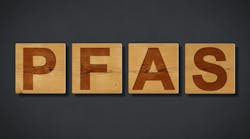Water’s Short and Long-Term Future is in Good Hands
By Greg Kail, Director of Communications, American Water Works Association
As we embark on the year 2024, the American Water Works Association’s Water 2050 initiative is helping the water community envision the long-term future of water and chart a course for success and sustainability. At the same time, AWWA’s 20th annual State of the Water Industry Report (SOTWI) shows many longstanding water challenges remain top of mind for water professionals today.
Atop the list of issues from SOTWI respondents is the renewal and replacement of aging water infrastructure, which has been ranked at or near the top in each of the survey’s 20 years. Despite the $55 billion infusion of federal cash to improve water and wastewater systems from the 2021 Infrastructure Investment and Jobs Act, SOTWI respondents also called out financing for capital improvements as the third-ranked issue.
With the U.S. Environmental Protection Agency’s Lead and Copper Rule Improvements (LCRI) likely to become final during 2024, it will be hard to consider water infrastructure renewal without the added challenge of identifying lead service lines throughout the United States and preparing strategies for removing them. Many utilities will see the Lead and Copper Rule’s required communication with customers as an opportunity to strengthen public trust, particularly among disadvantaged communities. These efforts are aligned with a recommendation from the Water 2050 Social/Demographics Think Tank: “By 2050, utilities across the entire water spectrum will transform from primarily technical and engineering organizations to also excel as communications and community engagement entities.”
The second-ranked issue in the SOTWI report has a decidedly Water 2050, forward-thinking ring to it. Respondents ranked long-term drinking water supply availability right behind aging infrastructure – up from the third-ranked concern in the previous survey. Additionally, watershed/source water protection jumped from seventh to fifth. These rising rankings are the result of increased concerns about climate change and the need to develop resilient water utilities.
Sustainable water supplies and innovative watershed protection were clear themes across each of the five Water 2050 think tanks. A think tank on economics recommended the water community “integrate climate impact and resiliency into economic and financial modeling,” a think tank on sustainability proposed a “shift to watershed-based thinking,” and a think tank on governance recommended that we “regionalize water utilities based on watersheds.” AWWA will continue to champion strong source water protection in 2024 by hosting its fourth Source Water Protection Week in September and supporting source water protection measures in the reauthorization of the Farm Bill.
Replenishing an aging workforce registered sixth on the list of issues in the SOTWI report and developing a diverse and techno-savvy workforce for the future was recommended in three different Water 2050 think tanks. During 2024, when we observe the 50th anniversary of the Safe Drinking Water Act, AWWA will recognize and celebrate the committed army of water professionals who tackle complex water issues – from PFAS and cybersecurity to equity and infrastructure – every day.
One clear parallel between the 4,123 State of the Water Industry respondents and the more than 130 think tank participants is their optimism about the water community’s ability to overcome present and future challenges. AWWA shares that optimism and is excited to see what water professionals accomplish together in 2024.
Protecting Water Systems and Their Customers
By Charles Stephens, Senior Executive Policy Director, National Rural Water Association
As 2023 winds down, the National Rural Water Association (NRWA) is reflecting on accomplishments achieved this year and is energized for the year ahead. The water/wastewater sector has many challenges, but three stand out: PFAS, the Lead and Copper Rule Improvements (LCRI) and Cybersecurity. In each of these instances, rural water and wastewater systems are disproportionately impacted due to small populations and lack of economies of scale. Rural communities should be considered in legislative and regulatory actions impacting the water sector, and NRWA will continue advocating on their behalf.
Regarding PFAS, Rural Water’s focus is protecting water systems and their customers from the potential billions of dollars in legal liability, remediation costs, and reputational risks associated with EPA’s proposed hazardous substance designation of PFOS and PFOA under the Comprehensive Environmental Response, Compensation, and Liability Act (CERCLA). CERCLA is intended to uphold a “polluter pays” principle. However, absent a statutory exemption from PFAS liability for drinking water and wastewater systems that passively receive PFAS, polluters could pass these costs on to customers, effectively creating a “public pays” principle.
PFAS testing and treatment costs are already placing significant financial burdens on our communities, and a designation of PFAS as a hazardous substance will only exacerbate that cost. This burden cannot be overlooked, and equitable solutions must be identified. Rural Water strongly supports the "Water Systems PFAS Liability Protection Act" legislation, introduced by Senator Lummis, which aligns with the goal to eliminate PFAS from the public's drinking water while preserving the essential "polluter pays" principle.
Continuing to address Cybersecurity must be a priority for all drinking water and clean water systems and is something NRWA will continue to advocate for. NRWA is reviewing potential cybersecurity options that are scalable, affordable, and easy to implement for our nation’s drinking water and wastewater systems. NRWA is already working closely with Congress on a Farm Bill initiative that would create a Cybersecurity Circuit Rider program; providing rural America with free, in-person, boots-on-the-ground cybersecurity assistance. NRWA looks forward to partnering with EPA, collaborating as a sector to harden our defenses against cyber threats.
Finally, NRWA applauds EPA's effort to protect public health by removing lead from our nation's drinking water. With the help of our 50 State Affiliates, Rural Water will help systems meet the LCRI’s ambitious goals, while also continuing to provide technical assistance and training each day. As an inaugural member of the “Get the Lead Out” Partnership, NRWA and our State Affiliates have been committed to this initiative from day one. As details of the LCRI are reviewed, NRWA will continue working with EPA to ensure our members are prepared to meet the challenges that lie ahead.
There are sure to be challenges Rural Water will face in 2024, but there will also be ample opportunity to continue the vital work we do each day. There is nothing we can’t accomplish when government and industry come together to ensure everyone has access to safe drinking water and clean wastewater services.





